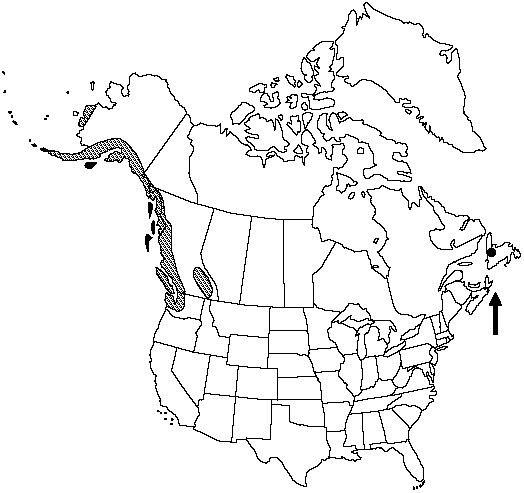FNA>Volume Importer |
FNA>Volume Importer |
| Line 32: |
Line 32: |
| | }}<!-- | | }}<!-- |
| | | | |
| − | --><span class="statement" id="st-d0_s0" data-properties="shoot orientation;shoot development;shoot atypical some measurement;shoot some measurement;shoot growth form;shoot growth form;shoot growth form;shoot some measurement"><b>Shoots </b>erect, determinate, 12–18 (–25) cm, clustered to long-decumbent, to 8 cm;</span> <span class="statement" id="st-d0_s1" data-properties="leaf size;portion life cycle;portion size;portion life cycle">leaves in mature portion smaller than leaves in juvenile portion;</span> <span class="statement" id="st-d0_s2" data-properties="constriction duration;constriction count">annual constrictions absent;</span> <span class="statement" id="st-d0_s3" data-properties="growth life cycle;growth shape;circle count;tip fixation or orientation;apex shape">juvenile growth sharply down-curled forming ± 1/2 circle, leaves at tip appressed to form pointed apex.</span> <span class="statement" id="st-d0_s4" data-properties="leaf coloration;leaf coloration;leaf coloration;leaf reflectance;portion life cycle;portion orientation;portion orientation;portion orientation;portion life cycle;portion orientation;portion orientation;portion orientation"><b>Leaves </b>in juvenile (proximal) portion spreading-reflexed (shade) to appressed-ascending (sun), in mature (distal) portion spreading-ascending (shade) to appressed-ascending (sun), light green to yellow, lustrous;</span> <span class="statement" id="st-d0_s5" data-properties="leaf architecture;leaf some measurement;portion life cycle;portion shape">leaves in juvenile portion narrowly lanceolate, parallel-sided, 4.5–7 mm;</span> <span class="statement" id="st-d0_s6" data-properties="leaf width;leaf some measurement;portion life cycle;portion shape">leaves in mature portion triangular, widest at base, 3.5–5.5 mm;</span> <span class="statement" id="st-d0_s7" data-properties="margin architecture or shape">margins entire;</span> <span class="statement" id="st-d0_s8" data-properties="stomate count;stomate count;stomate count;leaf count">stomates present on both surfaces, numerous, 35–80 per 1/2 leaf on adaxial surface.</span> <span class="statement" id="st-d0_s9" data-properties="branchlet architecture;pseudowhorl count;growth duration"><b>Gemmiferous </b>branchlets produced in 2–3 pseudowhorls at end of annual growth;</span> <span class="statement" id="st-d0_s10" data-properties="gemma length;gemma width;lateral leaf width;lateral leaf shape;tip shape">gemmae 3.5–5 X 3–4 mm, lateral leaves 1.25–1.75 mm wide, acute with acuminate tip.</span> <span class="statement" id="st-d0_s11" data-properties="spore some measurement"><b>Spores </b>25–34 µm.</span><!-- | + | --><span class="statement" id="st-undefined" data-properties=""><b>Shoots </b>erect, determinate, 12–18(–25) cm, clustered to long-decumbent, to 8 cm; leaves in mature portion smaller than leaves in juvenile portion; annual constrictions absent; juvenile growth sharply down-curled forming ± 1/2 circle, leaves at tip appressed to form pointed apex. <b>Leaves</b> in juvenile (proximal) portion spreading-reflexed (shade) to appressed-ascending (sun), in mature (distal) portion spreading-ascending (shade) to appressed-ascending (sun), light green to yellow, lustrous; leaves in juvenile portion narrowly lanceolate, parallel-sided, 4.5–7 mm; leaves in mature portion triangular, widest at base, 3.5–5.5 mm; margins entire; stomates present on both surfaces, numerous, 35–80 per 1/2 leaf on adaxial surface. <b>Gemmiferous</b> branchlets produced in 2–3 pseudowhorls at end of annual growth; gemmae 3.5–5 × 3–4 mm, lateral leaves 1.25–1.75 mm wide, acute with acuminate tip. <b>Spores</b> 25–34 µm.</span><!-- |
| | | | |
| | -->{{Treatment/Body | | -->{{Treatment/Body |
| Line 60: |
Line 60: |
| | |publication year=1981 | | |publication year=1981 |
| | |special status= | | |special status= |
| − | |source xml=https://jpend@bitbucket.org/aafc-mbb/fna-fine-grained-xml.git/src/287ef3db526bd807d435a3c7423ef2df1e951227/V2/V2_457.xml | + | |source xml=https://jpend@bitbucket.org/aafc-mbb/fna-data-curation.git/src/9216fc802291cd3df363fd52122300479582ede7/coarse_grained_fna_xml/V2/V2_457.xml |
| | |genus=Huperzia | | |genus=Huperzia |
| | |species=Huperzia miyoshiana | | |species=Huperzia miyoshiana |
| − | |apex shape=pointed
| |
| − | |branchlet architecture=gemmiferous
| |
| − | |circle count=1/2
| |
| − | |constriction count=absent
| |
| − | |constriction duration=annual
| |
| − | |gemma length=3.5mm;5mm
| |
| − | |gemma width=3mm;4mm
| |
| − | |growth duration=annual
| |
| − | |growth life cycle=juvenile
| |
| − | |growth shape=down-curled
| |
| − | |lateral leaf shape=acute
| |
| − | |lateral leaf width=1.25mm;1.75mm
| |
| − | |leaf architecture=parallel-sided
| |
| − | |leaf coloration=light green;yellow
| |
| − | |leaf count=1/2
| |
| − | |leaf reflectance=lustrous
| |
| − | |leaf size=smaller
| |
| − | |leaf some measurement=3.5mm;5.5mm
| |
| − | |leaf width=widest
| |
| − | |margin architecture or shape=entire
| |
| − | |portion life cycle=mature;juvenile;mature;juvenile;juvenile;mature
| |
| − | |portion orientation=spreading-ascending;appressed-ascending
| |
| − | |portion shape=triangular;lanceolate
| |
| − | |portion size=smaller
| |
| − | |pseudowhorl count=2;3
| |
| − | |shoot atypical some measurement=18cm;25cm
| |
| − | |shoot development=determinate
| |
| − | |shoot growth form=clustered;long-decumbent
| |
| − | |shoot orientation=erect
| |
| − | |shoot some measurement=0cm;8cm
| |
| − | |spore some measurement=25um;34um
| |
| − | |stomate count=35;80
| |
| − | |tip fixation or orientation=appressed
| |
| − | |tip shape=acuminate
| |
| | }}<!-- | | }}<!-- |
| | | | |
| | -->[[Category:Treatment]][[Category:Huperzia]] | | -->[[Category:Treatment]][[Category:Huperzia]] |
Shoots erect, determinate, 12–18(–25) cm, clustered to long-decumbent, to 8 cm; leaves in mature portion smaller than leaves in juvenile portion; annual constrictions absent; juvenile growth sharply down-curled forming ± 1/2 circle, leaves at tip appressed to form pointed apex. Leaves in juvenile (proximal) portion spreading-reflexed (shade) to appressed-ascending (sun), in mature (distal) portion spreading-ascending (shade) to appressed-ascending (sun), light green to yellow, lustrous; leaves in juvenile portion narrowly lanceolate, parallel-sided, 4.5–7 mm; leaves in mature portion triangular, widest at base, 3.5–5.5 mm; margins entire; stomates present on both surfaces, numerous, 35–80 per 1/2 leaf on adaxial surface. Gemmiferous branchlets produced in 2–3 pseudowhorls at end of annual growth; gemmae 3.5–5 × 3–4 mm, lateral leaves 1.25–1.75 mm wide, acute with acuminate tip. Spores 25–34 µm.
Habitat: On rock or terrestrial on moss-covered boulders in talus slopes, cliffs, near waterfalls, marshes in conifer forest
Elevation: 0–1600(–1800) m
Distribution
B.C., Nfld., Alaska, Wash., Asia in Japan, Korea, Siberia.
Discussion
Selected References
None.
